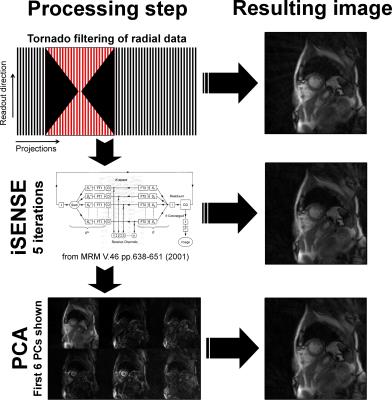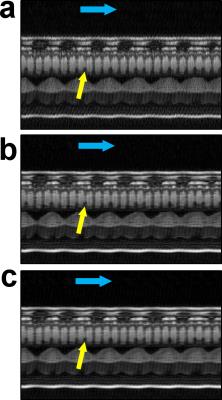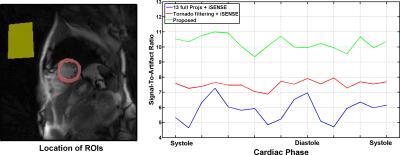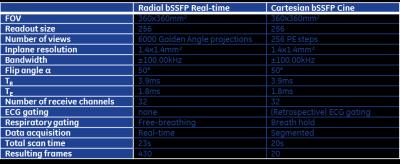2867
Real-Time Cardiac Functional Imaging Using an Arrhythmia-Robust Radial Imaging Sequence1GE Global Research Europe, Garching bei München, Germany, 2Cardiac Center of Excellence, GE Healthcare, Garching bei München, Germany, 3GE Healthcare, Menlo Park, CA, United States, 4GE Healthcare, Madison, WI, United States, 5Radiology, University of Wisconsin - Madison, Madison, WI, United States, 6Medical Physics, University of Wisconsin - Madison, Madison, WI, United States, 7GE Healthcare, Waukesha, WI, United States
Synopsis
Cardiac cine datasets are difficult to obtain in the presence of arrhythmia or poor gating signal. Here, completely ungated radial real-time imaging may help. Cartesian real-time imaging usually offers compromised spatial resolution to maintain sufficient temporal resolution. Hence, we propose a radial bSSFP-based real-time approach with Golden Angle increment which enables view sharing of temporally adjacent projections. To minimize temporal blurring, a narrow tornado shaped filter, followed by subsequent iterative SENSE reconstruction, was used. Remaining streaking artifacts were reduced by a principal component analysis based technique. Results show good agreement in terms of image quality to a standard Cartesian cine dataset.
Purpose
Cardiac functional parameters are measured on most cardiac MRI patients. ECG-triggered segmented cardiac cine imaging is the standard technique for obtaining temporally and spatially resolved information about cardiac function over a complete cardiac cycle. However, the final image series in cine imaging displays an average cardiac cycle and can be challenging in the presence of arrhythmia, poor breath-holding, or poor cardiac gating signals. In these cases, completely ungated real-time imaging may help. However, this usually comes at the cost of compromised spatial resolution to maintain a sufficient temporal resolution. Real-time golden-angle radial imaging1 offers the possibility of view sharing between temporally adjacent data. Moreover, radial sequences are intrinsically more motion robust compared to Cartesian sequences. To enable fully-ungated real-time cardiac cine imaging with high spatial and temporal resolution, we developed a technique that combines golden-angle radial imaging, tornado-shaped temporal filtering2, and iterative SENSE (iSENSE) reconstruction3. The proposed technique would allow for accurately measuring various cardiac functional parameters in patients in whom conventional segmented cine acquisition is inapplicable.Methods
Healthy volunteer real-time MRI images were acquired using Golden Angle bSSFP-based radial imaging on a 3.0T MRI scanner (MR750, GE Healthcare, Waukesha, WI, USA). Imaging was performed over 23s during free-breathing and without any cardiac gating. Scan parameters are provided in Table 1. Image reconstruction was performed offline using Matlab (The MathWorks Inc., Natick, MA, USA). A tornado-shaped filter was implemented for data sharing employing a temporal footprint of the fully sampled k-space region of 13 projections (Fig.1), which minimizes temporal blurring. The filter was then framewise shifted by 13 projections to maintain a nominal temporal resolution around 50ms, which is close to the SCMR guidelines for cine imaging (≤45ms)4. The applied tornado filter only spans approx. 25% of the radial Nyquist range in outer k-space to further reduce temporal blurring. The missing data were synthesized using iSENSE with 5 iterations, which significantly reduced streaking artifacts. Finally, to improve the apparent SNR of the resulting images and minimize remaining streaking artifacts, a truncated principal component analysis5 (PCA) was performed, which maintained at least 99.5% of the L1 energy of the original principal components (PCs). The reconstructed data were compared to a product segmented Cartesian SSFP Cine sequence with parameters given in Table 1, as well as an iSENSE reconstruction (5 iterations) of the timeframes from 13 full projections (i.e., the central part of the Tornado filter) for lowest possible temporal blurring.Results
Fig.2 shows a time-course of a signal intensity profile in a short-axis image using different reconstruction schemes. Undersampling (13 projections) resulted in compromised image quality and reduced SNR (Fig.2a), which improved using the tornado filter (Fig.2b), at the expense of slightly increased temporal blurring. Adding the PCA-based streaking removal increased apparent SNR and further improved image quality (Fig.2c). Fig.3 confirms this by displaying the quantified signal-to-artifact ratios of the investigated techniques from Fig.2. Fig.4 demonstrates the benefit of using the temporally narrow tornado filter on the resulting image quality. Even though temporal blurring is lowest in the iSENSE reconstruction of 13 full projections, image quality is compromised due to the low amount of data. On the other hand, the proposed reconstruction scheme offers high spatial and temporal resolution. The resulting images are in good agreement with standard segmented Cartesian cine images in terms of image quality and cardiac phase depiction.Discussion & Conclusion
The proposed technique allows for real-time cardiac functional imaging with high spatial and temporal resolution using free-breathing scans without ECG gating. The resulting dataset demonstrates very good agreement in terms of image quality with a standard Cine sequence. Compared to the images reconstructed from only the central part of the tornado filter, the proposed technique resulted in significantly improved image quality despite a slightly increased temporal blurring. Due to its insensitivity to ECG variation, lack of breath-holding, and maintained sharp myocardial boundaries, the proposed technique would be optimal for patients with arrhythmia, compromised cardiac gating signal, or poor breath holders, e.g. pediatrics and the elderly. Furthermore, due to the technique’s intrinsic motion robustness, it would be less affected by motion artifacts, which minimizes repeated scans and improves productivity. In contrast to previously published techniques6-8, our approach is less computationally expensive and does not require tuning of regularization parameters. This lowers the burden for a clinical implementation. In conclusion, the developed real-time golden-angle radial imaging sequence with iSENSE reconstruction and PCA destreaking is a promising tool for accurate cardiac functional evaluation in patients in whom conventional segmented Cartesian cine imaging is infeasible.Acknowledgements
No acknowledgement found.References
1. Winkelmann S, Schaeffter T, Koehler T, et al.; IEEE Trans Med Imaging V.26 pp.68-76 (2007)
2. Barger A, Block W, Toropov Y, et al.; Magn Reson Med V.48 pp.297-305 (2002)
3. Pruessmann K, Weiger M, Börnert P, et al.; Magn Reson Med V.46 pp.638-651 (2001)
4. Kramer CM, Barkhausen J, Flamm SD, et al.; J Cardiovasc Magn Reson V.15 paper 91 (2013)
5. Lin W, Guo J, Rosen M, Song H; Magn Reson Med V. 60 pp.1135-1146 (2008)
6. Gamper U, Boseiger P, Kozerke S; Magn Reson Med V.59 pp.365-373 (2008)
7. Uecker M, Zhang Z, Frahm J; Magn Reson Med V.63 pp.1456-1462 (2010)
8. Voit D, Zhang S, Unterberg-Buchwald C, et al.; J Cardiovasc Magn Reson V.15 paper 79 (2013)
Figures




